Lorica segmentata
The lorica segmentata (Latin pronunciation: [loːr̺iːka sɛgmɛnt̪aːt̪a]) is a type of personal armour that was used by soldiers of the Roman Empire, consisting of metal strips ("girth hoops" fashioned into circular bands), fastened to internal leather straps. The Latin name translates to "segmented cuirass" and was first used in the 16th century; the Roman appellation is unknown.
.jpg)
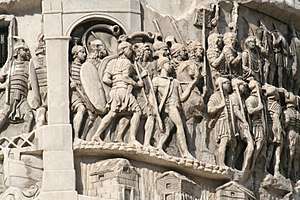
 | |
| Part of a series on the | |
| Military of ancient Rome | |
|---|---|
|
|
|
| |
The plates of lorica segmentata armour were soft iron inside and (some at least) were mild steel on the outside, making the plates hardened against damage without becoming brittle.[1] This case hardening was done deliberately by packing organic matter tightly around them and heating them in a forge, transferring carbon from the burnt materials into the surface of the metal.[2] The strips were arranged horizontally on the body, overlapping downwards, and they surrounded the torso in two halves, being fastened at the front and back. The upper body and shoulders were protected by additional strips ("shoulder guards") and breast- and backplates. The form of the armour allowed it to be stored very compactly, since it was possible to separate it into four sections, each of which would collapse on itself into a compact mass. The fitments that closed the various plate sections together (buckles, lobate hinges, hinged straps, tie-hooks, tie-rings, etc.) were made of brass. In later variants dating from around 75–80 A.D., the fastenings of the armour were simplified. Bronze hinges were removed in favour of simple rivets, belt fastenings utilised small hooks, and the lowest two girdle plates were replaced by one broad plate.
History
During the time of their use, this style of armour evolved and changed, the currently recognised types being the Dangestetten-Kalkriese-Vindonissa type from 9 BC to AD 43, the Corbridge-Carnuntum type from 69 to 100 and the Newstead type from 164 to 180, named after their places of discovery.[3] There was, however, a considerable overlap between these types in use, and the Corbridge and Newstead types are often found at the same sites (e.g. at Caerleon in Wales, Carnuntum in Austria, Carlisle in England and León in Spain). It is possible that there was a fourth type, covering the body with segmented armour joined to scale shoulder defences. However, this is only known from one badly-damaged statue originating at Alba Iulia in Romania. The currently accepted range for the use of the armour is from about 14 B.C. (depiction on the arch of Susa)[4] to the late 3rd century A.D. (León). Its use was geographically widespread, but mail (lorica hamata) may have been more common at all times.
Uses
The question as to precisely who used the armour is debated. There is a clear difference in armour between the two corps shown on Trajan's Column. This is a monument erected in 113 in Rome to commemorate the conquest of Dacia by Emperor Trajan (ruled 98–117): its bas-reliefs are a key source for Roman military equipment. Auxilia are generally shown wearing mail, cuirasses, and carrying oval shields. Legionaries are uniformly depicted wearing the lorica segmentata and carrying the curved rectangular shield.[5] On this basis, it has been supposed that lorica segmentata was used by legionaries only. However, some historians consider Trajan's Column to be inaccurate as a historical source due to its inaccurate and stylised portrayal of Roman armour: "it is probably safest to interpret the Column reliefs as ‘impressions’, rather than accurate representations." [6]
The view that auxilia were light troops originates from Vegetius' comment that "auxilia are always joined as light troops with the legions in the line".[7] It is true that some specialist units in the auxilia, such as Syrian archers and Numidian cavalry wore light armour (or none). But they were a small minority of the auxilia. Most auxiliary cohortes contained heavy infantry similar to legionaries.[8]
However, on another Trajanic monument (the Adamclisi Tropaeum) the lorica segmentata does not appear at all, and legionaries and auxilia alike are depicted wearing either mail or scales (lorica squamata). Some experts are of the opinion that the Adamclisi monument is a more accurate portrayal of the situation,[9] the segmentata used rarely, maybe only for set-piece battles and parades. This viewpoint considers the figures in Trajan's Column to be highly stereotyped, in order to distinguish clearly between different types of troops.[10] In any event, both corps were equipped with the same weapons: gladius (a close-combat stabbing sword) and javelins, although the type of javelin known as pilum seems to have been provided to legionaries only.[11] Goldsworthy points out that the equipment of both corps were roughly equal in weight.[8]
In recent years archaeologists have found fittings of loricae segmentatae in many fort sites that are thought to have been garrisoned by only auxiliary troops, i.e., where the legions were not based. If the legions were, indeed, broken up and distributed around all these small bases, then it implies a tactical use of the legions that has not previously been considered. Hitherto, the legions were regarded as shock troops employed only en masse and not broken up into detachments. M.C. Bishop, however, has argued that there is a need to examine the way in which the various troop types were armed and deduce from this what their battle roles were, rather than trying to consider who wore what. The legions were armed and trained for close-order combat while the auxiliary forces, just as numerous, were more accustomed to open order fighting, although they could be employed as the legions were (e.g. at Mons Graupius) if circumstances demanded this.[12]
Last uses and disappearance
During the 3rd century, all peregrini were granted Roman citizenship, and therefore legionaries lost their social superiority.[13] The lorica segmentata eventually disappeared from Roman use, although it appears to have still been in use into the early 4th century, being depicted in the Arch of Constantine erected in 315 during the reign of Constantine I to commemorate his military achievements. (However, it has been argued that these depictions are from an earlier monument by Marcus Aurelius, from which Constantine incorporated portions into his Arch.)[14]
Popular culture
The lorica segmentata has come to be viewed as iconic of the Roman legions in popular culture. The tendency to portray Roman legionaries clad in this type of armour often extends to periods of time that are too early or too late in history.
Gallery
.jpg) Relief from Trajan's Column showing a legionary with lorica segmentata, manning a carroballista
Relief from Trajan's Column showing a legionary with lorica segmentata, manning a carroballista.jpg) Detail of Trajan's Column
Detail of Trajan's Column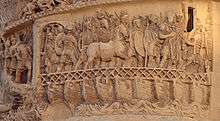 Roman legionaries crossing the Danube River by pontoon bridge, as depicted in relief on the column of Emperor Marcus Aurelius (r. 161-180 AD) in Rome, Italy
Roman legionaries crossing the Danube River by pontoon bridge, as depicted in relief on the column of Emperor Marcus Aurelius (r. 161-180 AD) in Rome, Italy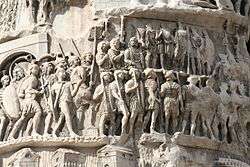 Column of Marcus Aurelius, Rome, Italy
Column of Marcus Aurelius, Rome, Italy A reenactor dressed as a Roman soldier in lorica segmentata
A reenactor dressed as a Roman soldier in lorica segmentata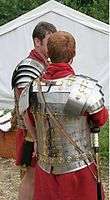
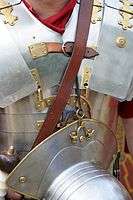

See also
- Laminar armour
- Manica – Roman armguard of similar construction
- Lorica plumata
References
- David Sim (at Reading University)
- "Iron for the Eagles", by David Sim & Isabel Ridge
- D'Amato & Sumner 2009, p. 131.
- D'Amato & Sumner 2009, p. 130.
- L. Rossi Trajan's Column and the Dacian Wars (Thames & Hudson 1971) 102
- Bishop, M.C. Lorica Segmentata Volume I p. 9-10
- Vegetius op cit II.2
- Goldsworthy Roman Warfare 127
- Mattingly op cit 207
- Rossi op cit 59
- Goldsworthy Complete Roman Army 136
- For a full discussion of this topic, see Bishop, M.C. (2002), "Lorica segmentata, Volume 1: A Handbook of Articulated Roman Plate Armour", Journal of Roman Military Equipment Studies, Monograph No.1.
- Goldsworthy Complete Roman Army 209
- Lorica Segmentata Volume I: A Handbook of Articulated Roman Plate Armour, Pg.21, Fig 2.4
Bibliography
- D'Amato, Raffaele; Sumner, Graham (2009). Arms And Armour of the Imperial Roman Soldier. Barnsley: Frontline Books. ISBN 978-1848325128.CS1 maint: ref=harv (link)
- Travis, Hilary; Travis, John (2011). Roman Body Armour. Amberley Publishing. ISBN 978-1-4456-0359-9.CS1 maint: ref=harv (link)
External links
| Wikimedia Commons has media related to Lorica segmentata. |
- Lorica Segmentata Volume I: A Handbook of Articulated Roman Plate Armour, M.C. Bishop, Armatura Press (November 1, 2002) (online version)
- Roman Army website, showing the third century finds of segmentata in spain (downloadable PDF)
- Ancient originals on the pages of the Roman Military Equipment Web Museum